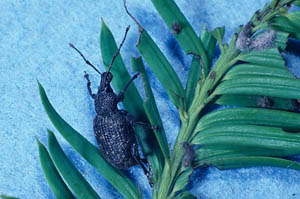Scouting Watch�� | |
|---|---|
| June 6, 2007 | |
|
Periodical cicada has emerged in northern Illinois. In the Chicago metropolitan area, high numbers have been reported in Downers Grove, Westmont, Glen Ellyn, Elmhurst, Lombard, Brookfield, Riverside, Hinsdale, LaGrange, Countryside, Palos Hills, Forest Hills, and Orland Park. Heavy emergence appeared to be several days later in Lake County, particularly within 1/2 mile of Lake Michigan. As of the end of May, broad estimates indicate that the numbers of cicadas present ranges from about one-tenth to one-third in the same areas in 1990, when this brood last emerged. Spiny elm caterpillars have been reported on hackberry in northeastern Illinois. These black, spiny caterpillars grow to about 2 inches long. They have a row of red blotches down the back. They tend to feed in groups, defoliating elm, hackberry, poplar, birch, linden, and willow. They are the larval stage of the mourning cloak butterfly. Because they are larval butterflies and attack trees that are vigorous and easily recover, small infestations are usually tolerated. Because they feed in groups, hand-removal of the larvae is an option, as well as sprays of Bacillus thuringiensis kurstaki (Dipel, Thuricide) and many other labeled insecticides. Gypsy moth caterpillar infestations with very noticeable defoliation have been reported in northeastern Illinois. The larvae are nearing pupation, resulting in poor insecticidal control. Bacillus thuringiensis kurstaki must be ingested by the caterpillars to be effective. As a caterpillar nears pupation, it greatly reduces and eventually stops feeding, so an insecticide that requires ingestion is ineffective. At the same time, the caterpillars start to break down and absorb the inner layers of its exoskeleton before molting to the next larval stage or pupal stage. This results in reduced connections between the outside of the caterpillar and its internal organs, causing even contact insecticides such as pyrethroids to be less effective. In other words, mature caterpillars are almost impossible to control short of stomping on them. Black vine weevil is treatable at this time throughout the state. They are in the adult stage and feeding on foliage. They must feed on yew, euonymus, and other host plants for about 2 weeks before they mature enough to lay eggs. Scout plants for the characteristic foliage notching before treatment. Spray foliage of attacked plants, allowing heavy runoff onto the debris below the shrubs and groundcovers. Acephate (Orthene), bifenthrin (Onyx, Talstar), and cyfluthrin (Tempo) are effective.  Mimosa webworm first generation is just starting in southern Illinois. Early damage by first generation will appear as two leaflets webbed together, with one or two caterpillars feeding on the leaves of honey locust and silk tree (mimosa). If there are large numbers of these scattered over the tree, spraying with Bacillus thuringiensis kurstaki (Dipel, Thuricide) or other labeled insecticide is recommended. Moths will lay eggs back into first-generation damage later in the season. The resulting second generation will web and damage several compound leaves, whereas only a few leaflets were damaged by the first generation. (Phil Nixon, James Schuster, Susan Grupp, Morton Arboretum) �� | |
| Author: | Jim Schuster Phil Nixon |
